An Ever-Evolving Classic Fixed Blade with a Ton of Upgrade Options
We spent several weeks testing the Bradford Guardian 3 to ensure complete coverage in this review. We have several versions featuring different handle scales and blade steel material, so feel free to ask questions in the comments section of this article.
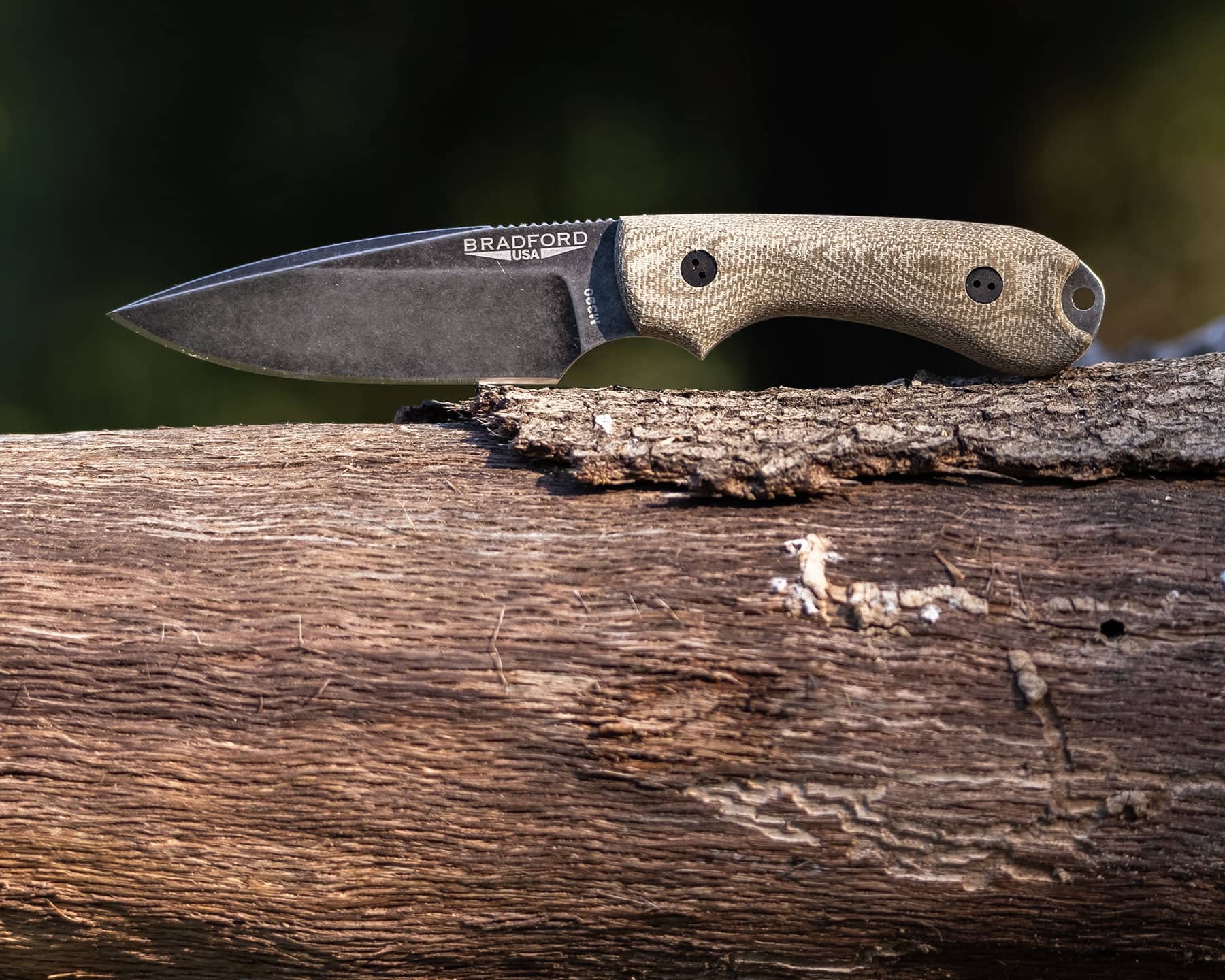
Table of Contents
The Guardian 3 is a carving tool. It’s not going to clear a trail for you or make it easy to split a log, but it’s a fantastic tool to take outdoors for any finer cutting tasks that need a good edge and a fine point.

It’s light on the belt and small enough that it never gets caught on branches when you’re pushing through heavy brush. The Micarta handle feels great in hand, and gives you a ton of control over the blade, which has an impressive combination of high-grade steel and good edge geometry.
If I hunted regularly, I would be ecstatic about this knife. As a fan of smaller, reliable knives I’m still pretty happy with it. There are a couple problems with it speaking from a wider survival and bushcraft perspective, mostly in that it sucks to try sparking on a ferro rod, but overall, the Guardian 3 is just nice to carry and use, and it looks a lot better than most other knives in its category.
Specifications
| Overall Length: | 6.75″ |
| Blade Length: | 3.5″ |
| Handle Length: | 3.25″ |
| Blade Steel: | AEB-L, M390 (plus a bunch of other options) |
| Blade Grind: | Flat |
| Blade Style: | Drop point |
| Handle Material: | Micarta or G-10 |
| Knife Weight: | 3.5 oz |
| Weight w/ Sheath: | 9.1 oz |
| Sheath: | Leather |
| Made in: | USA |
| Price Range: | $100 – 190 (depending on material) |
Pros
| Comfortable handle |
| Near weightless on the belt |
| Great blade for skinning and finesse work |
| Great steel and finish |
Cons
| Hard to spark off a ferro rod |
| Small belt loop on sheath |
| Restricted to horizontal carry with stock leather sheath |
The Sheath – Leather and the Big Belt Problem
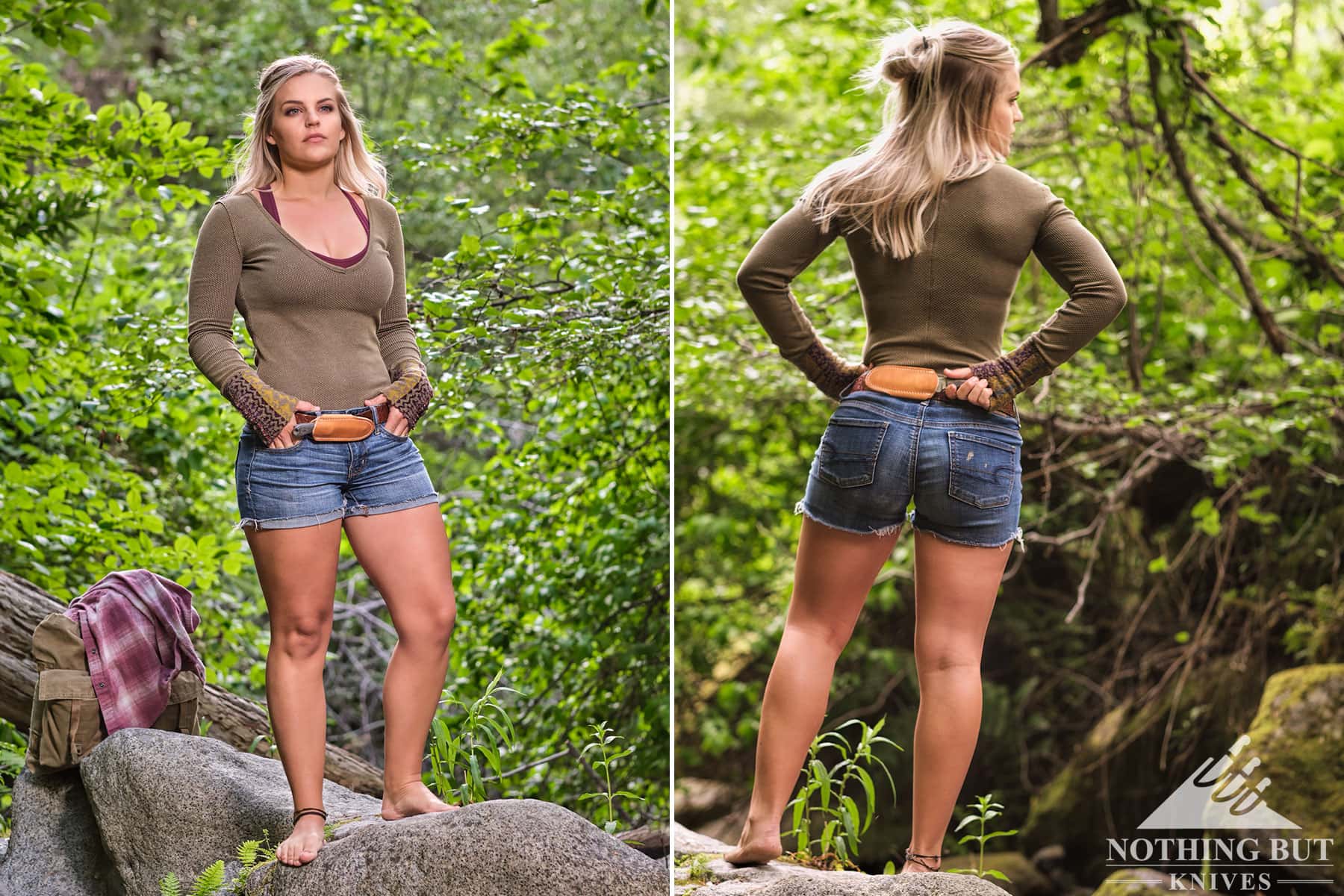
The first thing you should check before buying this knife is how tall your belt is. The belt loop is maybe 2 inches tall, and the leather is grippy, so it can easily turn into a tight squeeze. The belt I use with the Guardian 3 is about an inch and a half tall and fairly thick and it works great, but it’s close.
If my belt were any bigger it would be too big to carry the Guardian. We did find that cloth belts and the kind of straps you’ll typically find on MOLLE packs can fold into the belt loop well enough, but it’s a little bit of an added irritation to strap this thing on.
Fortunately the sheath has excellent retention. No matter how you carry it, the knife isn’t going to slip out. Just make sure you have a belt that fits it or get the Kydex sheath.
The other potential issue is that the leather sheath possibly has a shorter lifespan than your typical polymer. Get used to the idea that the pretty leather is going to get marked up as you draw and sheath the knife. If you’re using this knife for the things it was made for, the sheath is going to get wet and cut and dropped and generally marked and torn up.
It’s nice leather and the stitching is holding up well enough for me so far, but eventually it will fail, and then I’ll have the option of either getting it repaired, ordering a replacement, or switching to Bradford’s Kydex system.
Fortunately, Bradford is a few steps ahead of me on this. They sell some handy add-ons and replacements for this knife, but we’ll get into that later.
Light Horizontal Carry
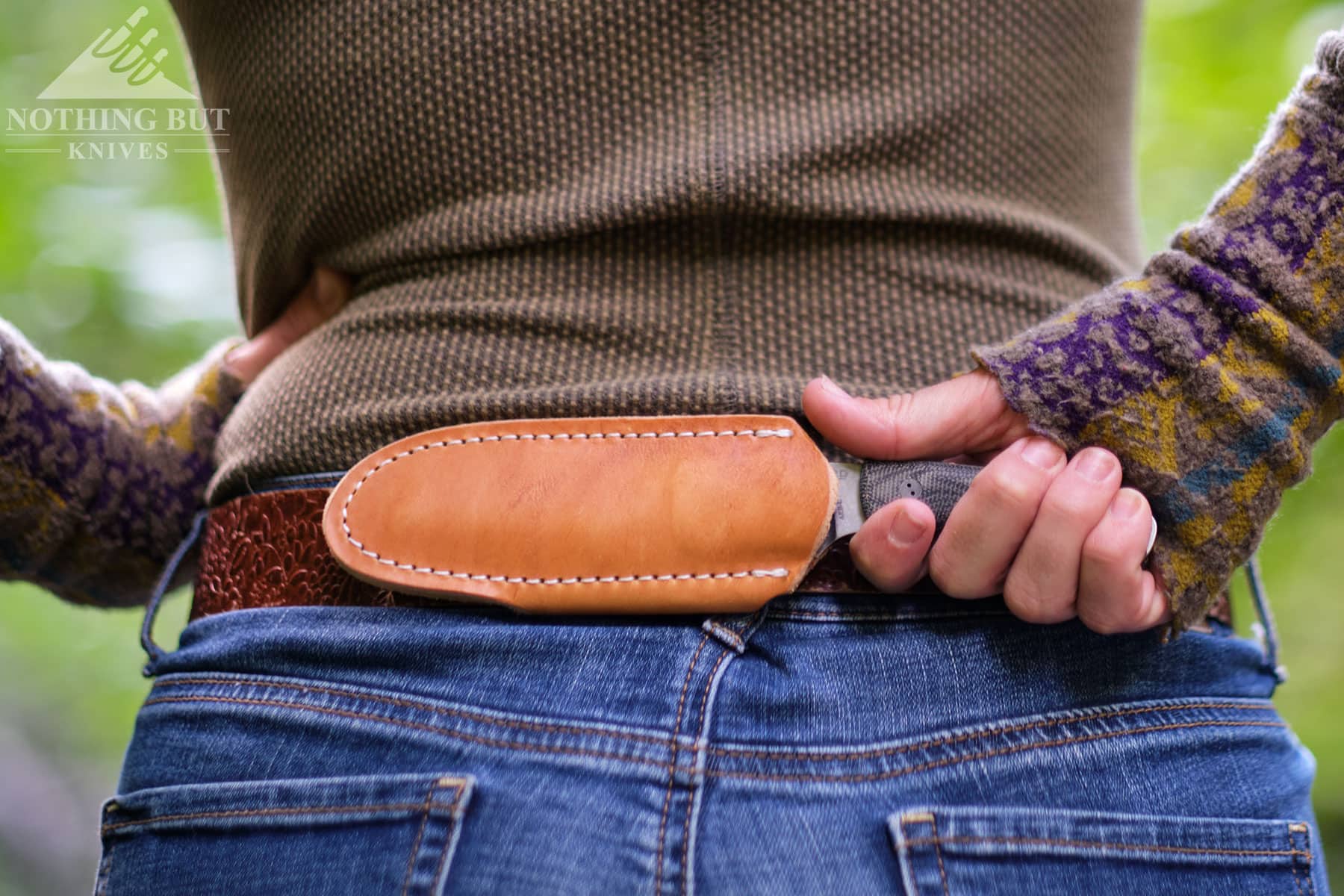
Once you get this thing on, it basically becomes a part of your pants. You hardly feel it at all. It hugs tight to the belt and sits deep enough in the sheath that the handle doesn’t stick out enough to hook on anything.
It benefits a lot from the knife fitting into the sheath with the blade going either direction. At one point we switched from scout carry to more of a front-hip carry and found the handle getting in the way of the belt buckle so we just switched the sheath to the other direction and flipped the knife around. It still rode comfortably and was a lot easier to deploy.
Like most smaller fixed-blade knives, I actually prefer wearing this on the front. It’s small enough that it doesn’t really interfere with me using my pants pockets, and I prefer drawing off my hip than my back. That said, it is much easier to negotiate with the sheath behind my back than other horizontal carries because it sits in one place so well.
Since it basically sits flush with the belt I always know where the sheath opening is, as opposed to a lot of the clunky Kydex sheaths I’ve dealt with that tend to sit half an inch or so off my back or actually pivot around so it’s hard to gauge exactly where I need to put the knife.
The Blade
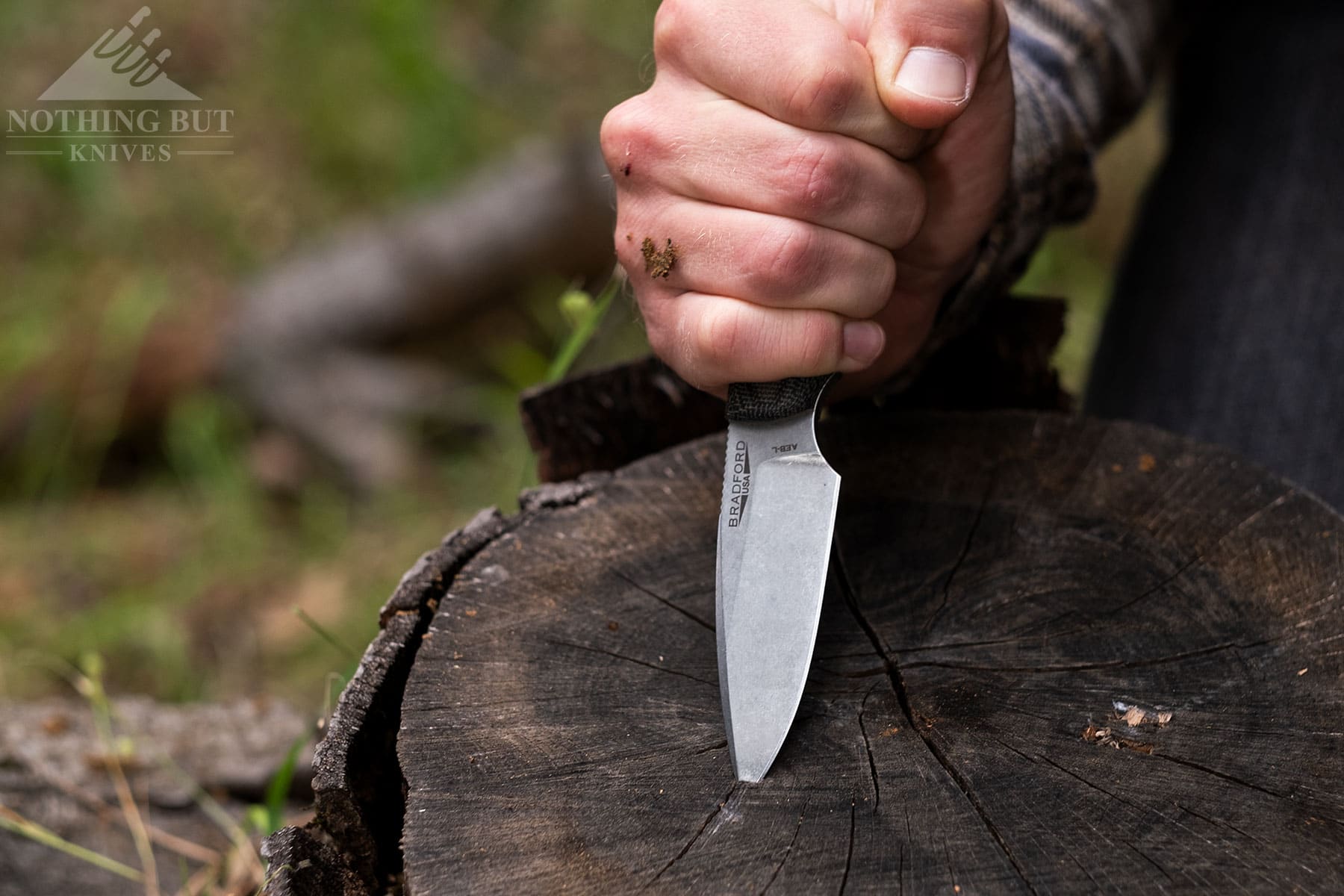
The blade on the Guardian 3 is incredible. It cuts well. It’s sharp and stays that way through a lot of abuse. The finish stays surprisingly clean too. Even after hacking and carving a few different kinds of wood there wasn’t a stain on it, and when I finally did get some tree marking on it they were easy to clean off.
The Guardian 3 is the first knife I’ve tested with Bohler N690 steel. I’ve always heard good things, but as someone who leans toward softer budget steels or tougher tool steels, I’ve never been in a hurry to try it. This stuff is nice, though. This knife takes a long time to get dull and doesn’t seem to chip easily at all.
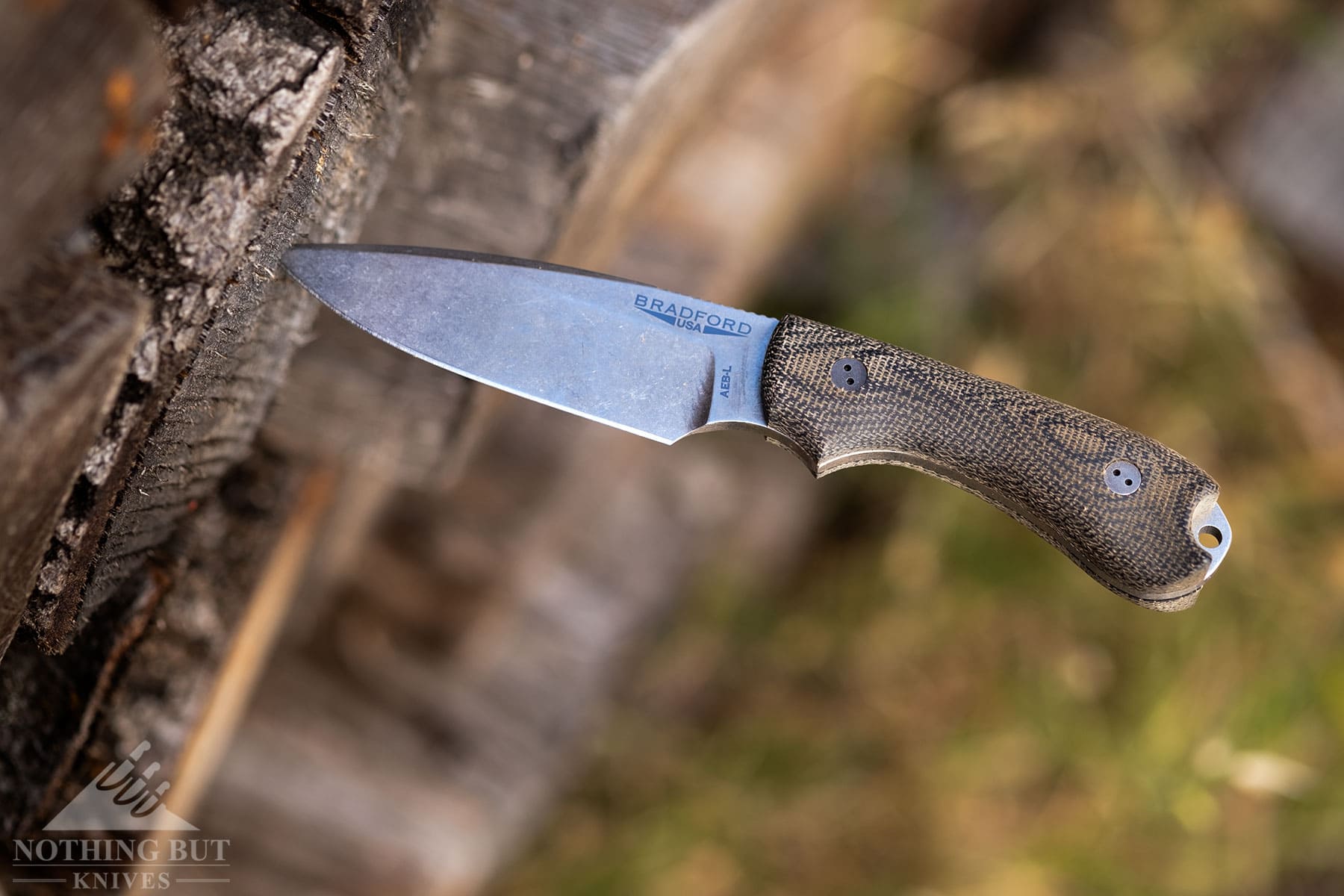
We spent the better part of an afternoon hitting stumps and logs with the Guardian 3 and when I took it home it still cut a clean line through paper without needing any stropping. It could just be Bradford’s heat treatment. I know their edge geometry and overall ability to craft a good blade probably has a lot to do with it, so maybe it would be safer to say this is an example of a good steel in the hands of good craftsman.
I’m still a D2 steel sort of person, though.
Blade Steel Update
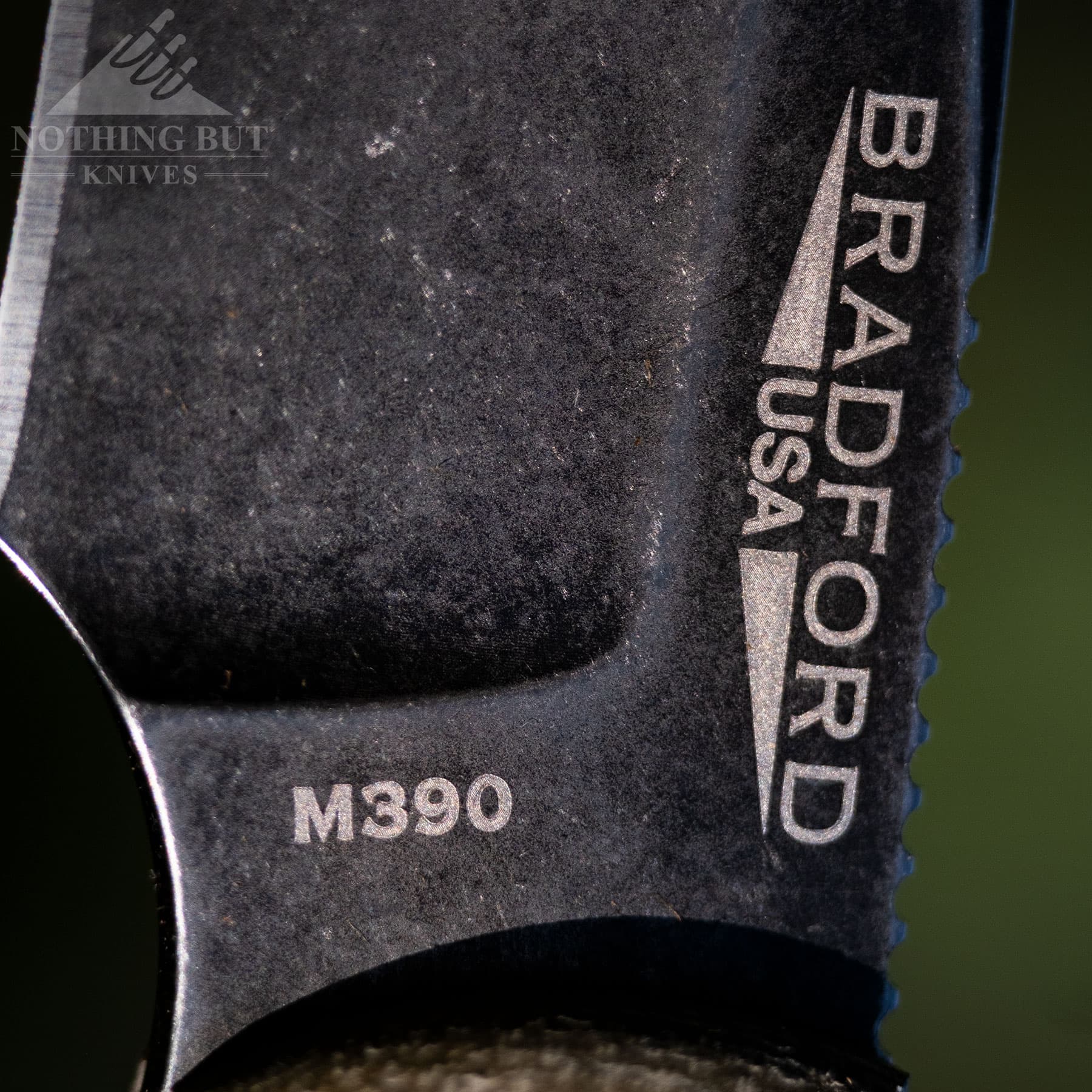
Some eagle-eyed readers pointed out that we had the AEB-L version of the Guardian 3 in the pictures. That’s the first version we got, and the one we mostly tested, but I was young and stupid when I first wrote this, and couldn’t get past all the hype I’d been reading about the Guardian 3 in Bohler N690 or M390 to look at what kind of blade I actually had.
Since then, not only have we picked up the M390 version, but Bradford has released dozens of new versions of the Guardian 3, including a D2 and G-10 variation.
This Table is a Quick Guide to the Steels Available on the Guardian 3
| AEB-L | The tough version. It has small carbides which means it can take a very fine edge and strops up super easy |
| M-390 | The harder version that holds an edge for a really long time, but might be more prone to micro chipping. |
| N-690 | More or less the halfway point between AEB-L and M390. I’ve heard it compared to VG-10, but it’s quite a bit tougher, especially after the people at Bradford get a hold of it. |
| D2 | The low-cost hard version with good edge retention and toughness, but likely a little more prone to microchipping than the N690 version. |
| CPM-3V | A tough tool steel with good edge stability at high hardness. Bradford typically puts it at 61 HRC, which is a great match. |
| CPM-M4 | Another tough, high-speed tool steel. It has a similar carbon content to D2 but tends to keep better toughness at high hardness. |
| Nitro-V | A similar composition to AEB-L, but with vanadium added. It has excellent edge stability and corrosion resistance |
| Vanadis 4 Extra | A high carbon powder steel that’s supposed to be highly resistant to chipping even at very high hardness. |
| Magnacut | Magnacut is a stainless steel with the edge retention of high carbon steel. It is the best of both worlds, but tough to sharpen. |
Most of these have a working hardness around 60 – 62 HRC. I know the temptation is to assume that the most expensive versions are the best, but they’ll all perform roughly the same. You should mostly feel a difference in the way each steel keeps and edge, and especially when you need to sharpen them.
If you want to get really deep into the debate you could look into things like the extensive knife steel testing and rating done by Knife Steel Nerds. The material is kind of dense, but it provides a great overview of how these steels (and a ton of others) measure up to each other in a controlled environment.
Also keep in mind that some of the steels I listed for the Guardian might be part of limited releases. I update this blog maybe a once or twice a year as I realize they’ve released or discontinued one version or another.
The Magnacut Comparison
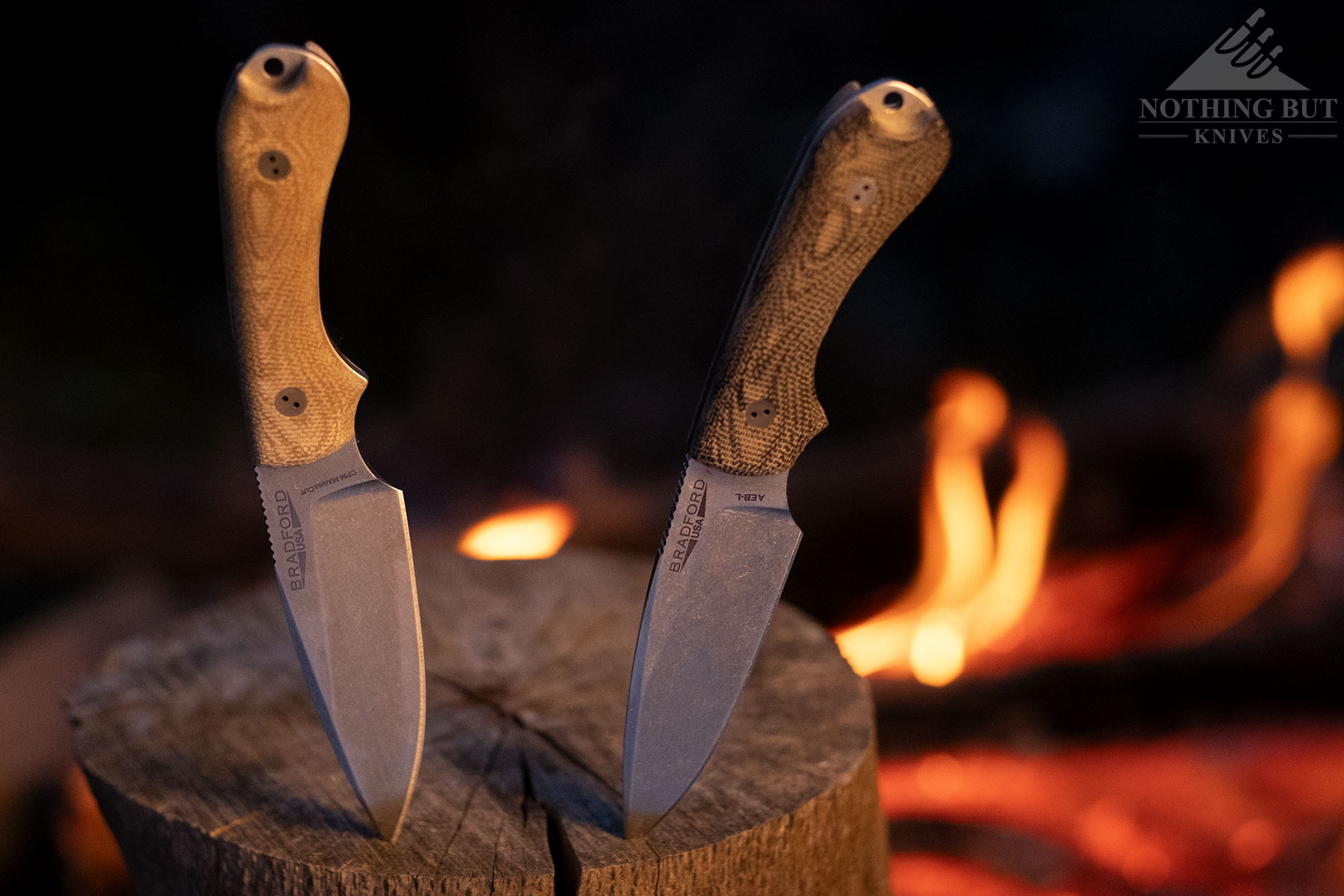
Speaking of limited runs, Bradford did a limited Magnacut release of the Guardian 3 in early 2022, and we decided it was a good opportunity to see what all the fuss was about. So we snatched one up and did a quick and dirty test against our AEB-L Guardian (after a bit of edge maintenance).
As of April 2024 it looks like the Magnacut version is a permanent steel option for the Guardian 3.
The Magnacut version came a lot sharper than the AEB-L did. Like almost push-cutting sharp. In theory this is because Magnacut is a powder steel with a smaller carbide structure and incredible edge stability. But it could also be that Bradford spent a little more time on this because it’s a limited run and they knew the people getting these things were going to have high expectations out of the box.
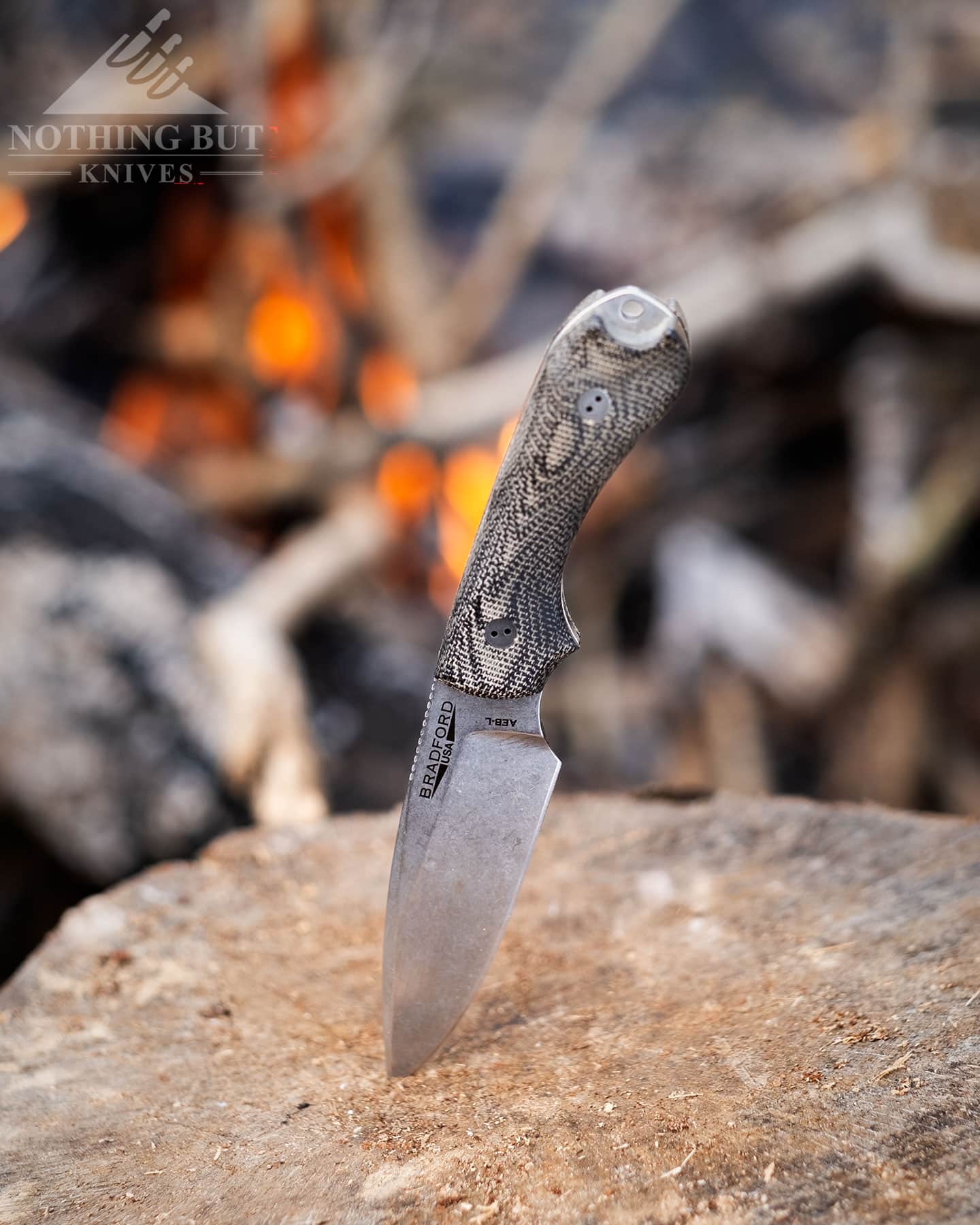
Regardless, I was more interested in seeing how easy each was to fix up after I used the edges into oblivion.
First I used them both to cut the same rope.
The AEB-L blade got a little hiccup in the blade after around 25 cuts. It took 60 cuts before the edge started to feel rougher on paper tests, though.
The Magnacut blade did somewhere around 130 cuts before I ran out of rope. There might have been a little hiccup in the edge, but it felt pretty much the same on paper.
Then I honed them both up and took them to a cardboard box each of the same size and thickness.
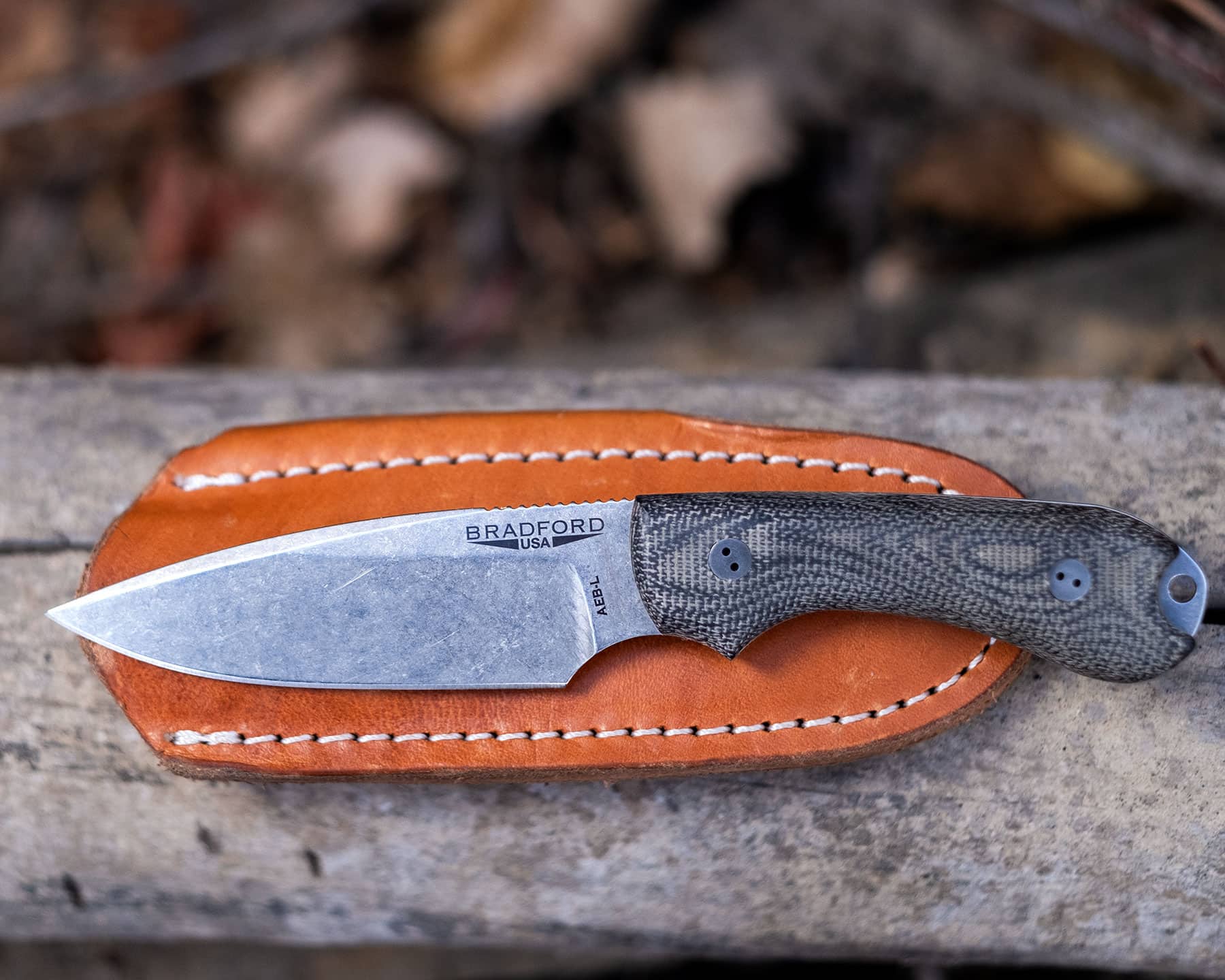
The AEB-L edge really started feeling rough after about 40 cuts. It finished up the box just fine, though.
The Magnacut blade did about 50 cuts well enough, and then the box was gone. I made a few more unnecessary cuts just to see if I could rough up the edge a little more, but it didn’t make a whole lot of difference. It did feel a little harsher on paper, but it was definitely still sharp.
As far as honing them up (honing and stropping was all I had to do on both blades after this round of testing), the AEB-L cleaned up after maybe 20 passes. I struggled a little bit with straightening the lip out completely because I’m just not very good at honing in general.
The Magnacut took about a dozen passes before it cut completely clean on paper again. And it was surprisingly easy to manage the edge even for me.
Obviously this wasn’t a fair test, and it wasn’t especially thorough. I knew going into it that Magnacut would perform better. But I wanted to know if it was at least $60 better. And I’d say if you plan on actually using your Guardian 3 for extended periods of time, the Magnacut upgrade is absolutely worth it. I would much rather have the stability of the Magnacut blade over the AEB-L on a long camping trip, and that’s saying a lot, because I love AEB-L. It’s far from a weak steel, but it doesn’t have anything like the wear resistance of Magnacut.
As a Survival Tool
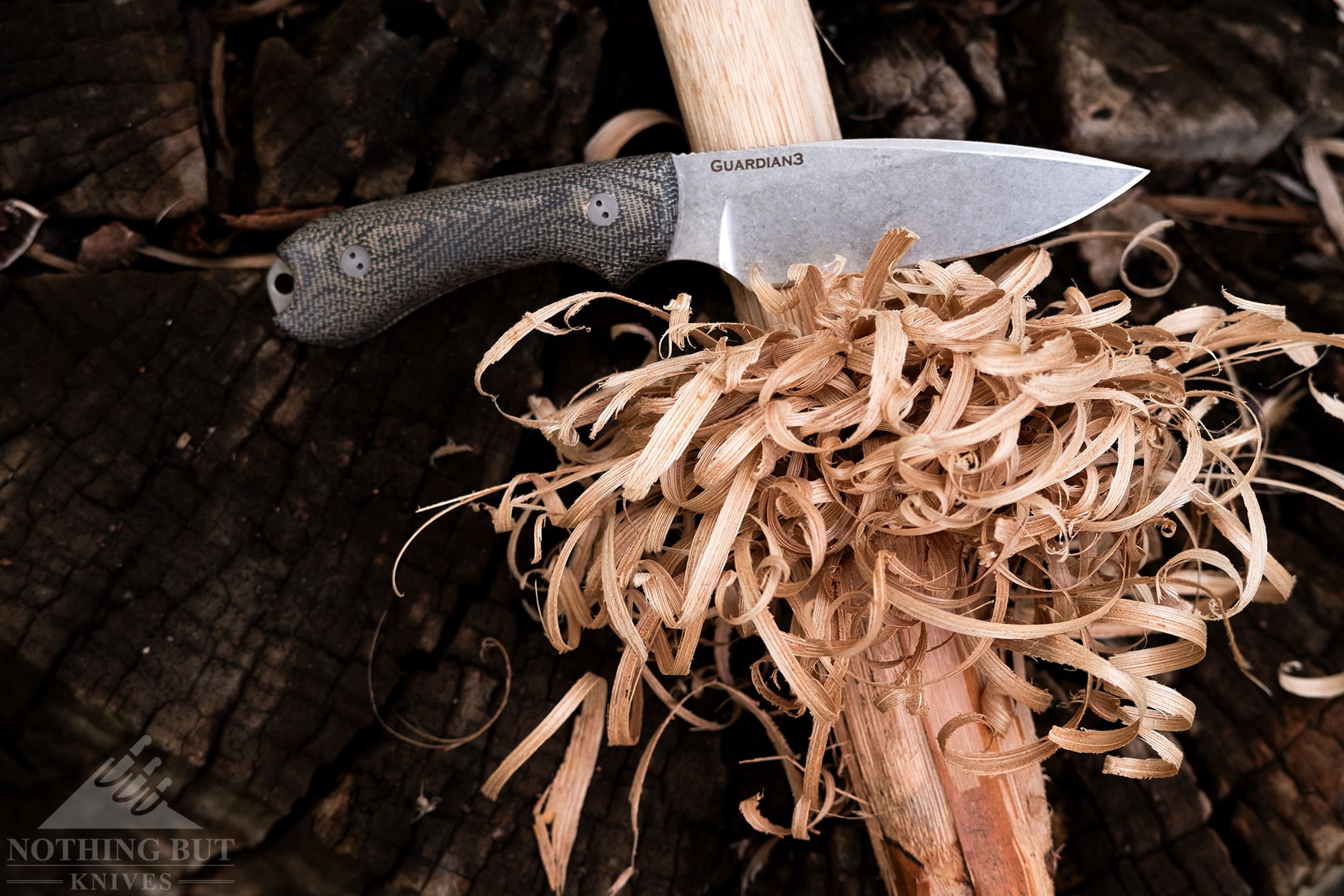
The Guardian is great for about 80% of what you’d probably be doing to survive in the wild.
You can cut rope, you can skin and gut most kinds of game with it, you can carve rudimentary tools with it, and you can feather stick like a champ with it.
I was the most surprised by how it chops. I didn’t expect to get anywhere at all trying to chop through a branch, but it turns out it’s pretty easy to swing this from the butt of the handle to get a little more momentum. It doesn’t match up to bigger knives like the Condor Stratos, and absolutely would not be my first choice for making firewood, but it could get some work done in that area if I didn’t have anything else.
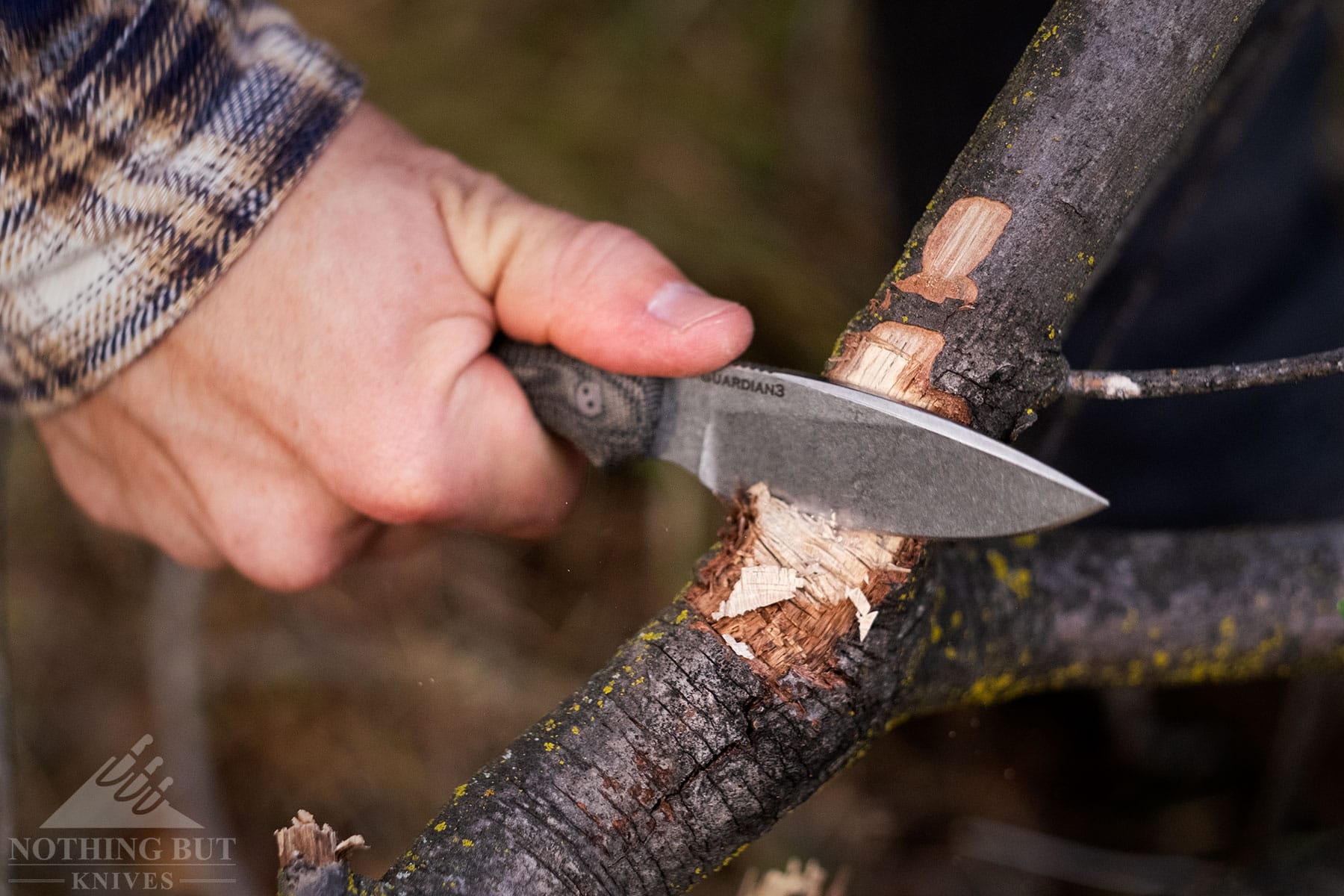
The Guardian 3’s biggest drawback is that the spine can’t throw sparks on a ferro rod. I tried it with a couple different rods we have lying around, but the spine is just too rounded for it to work. The only spot you can get sparks off of is the finger choil, which has always been the most awkward place to use for me.
It forces you to risk slamming the edge into whatever surface you’re building a fire on. Maybe it’s a necessary evil to round the spine out for the sake of the blade’s point on a knife this small, but that’s not going to stop me from complaining when I inevitably smash the edge into a rock hidden in the dirt below the wood shavings I’m trying to light.
I might be more willing to forgive having to throw sparks off the finger choil if the knife worked well with a ferro rod, but it ended up being a lot of work to get one or two sparks off it, and it was almost impossible to get it to spark consistently. It was all around a bit of a nightmare trying to get anything to light with this knife. The thing looks great from afar, but I’d be willing to forgo a bit of the buttery smooth look if they just gave me a little bit of flat spine to work with.
The Handle and Ergonomics
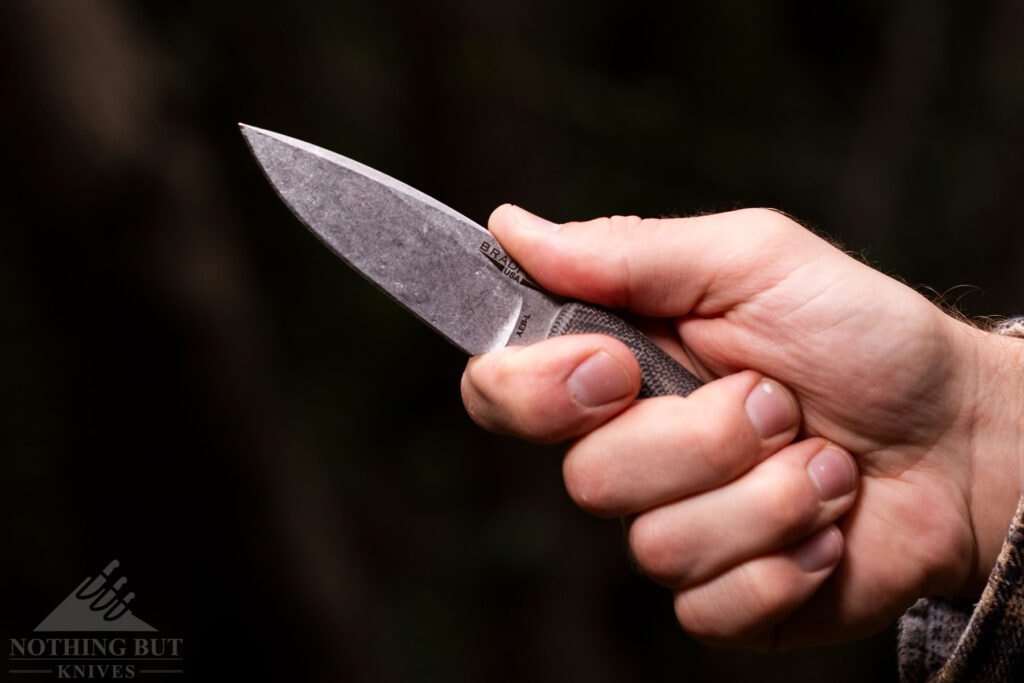
The handle is comfortable in spite of its size. My hand is a little cramped on it, but the scales make a nice wide grip, and they feel good to tighten up on. There’s also a surprising amount of variety in terms of grips on this knife.
It’s pretty secure in an ice-pick grip. I never felt like I was in danger of slipping when I was slapping it into the top of a stump to test the tip. The reverse grip can be a little uncomfortable because of the curvature of the handle, but the texture and swell of the scales make it bearable.
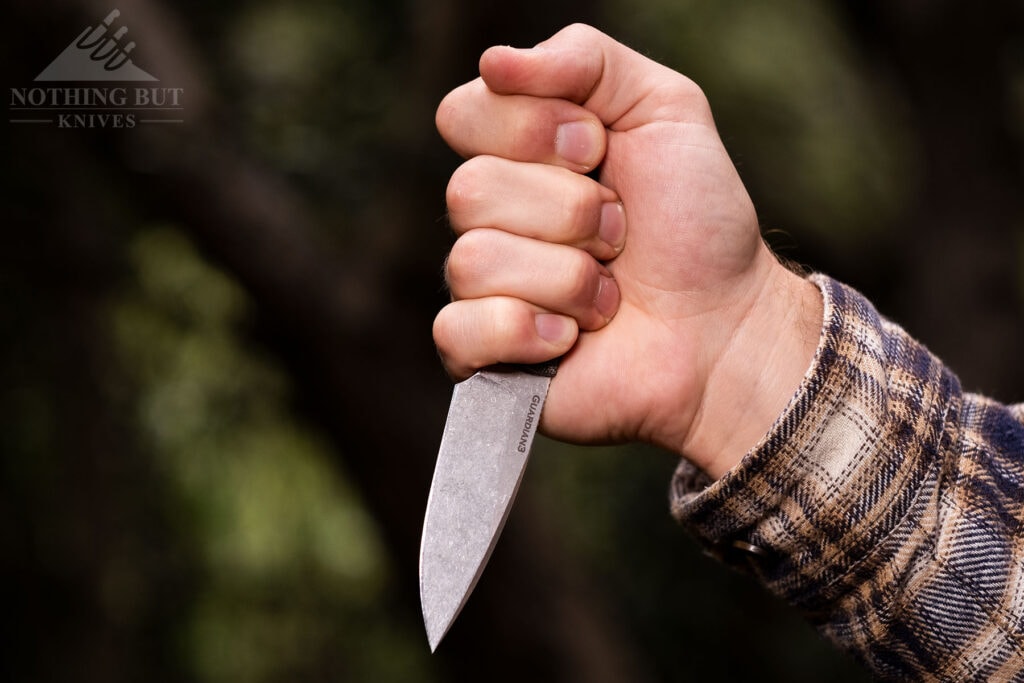
You can also, like I said before, grip it from the butt for a little extra momentum if you’re chopping. That’s not something you want to do with this knife, though. It’s just something the knife can do if you have nothing better handy. You’ll also have to hold the knife that way for striking a ferro rod since the finger choil is the only place that will throw a spark, but I already complained about that.
This knife comes in a G-10 version, which is good for getting this design at a lower price. That one usually runs at least $50 cheaper, but after handling the Micarta handle I would really hate to try anything else. I’m sure the handle shape still fits the hand well enough, but it’s not going to have all the smooth curvature of the Micarta Guardians.
Maybe I’ll snatch up a G10 version one of these days and do a side-by-side just to see how different the comfort level actually is, but as long as we’re just talking about the Micarta version, Bradford gets full marks.
Cool Add-Ons
Something really nice about this knife is that the few parts of it that are detachable (the scales and the sheath) are really easy to replace and swap with other stuff. Bradford sells different kydex sheaths and G10 and Micarta scales off their website, and it doesn’t take much digging to find a host of customizers who sell their own interesting additions to this knife. It benefits a lot from its popularity in that sense.
It’s a great answer for anyone who says the knife is too expensive or that the leather sheath will wear out eventually. If the Micarta is too much, start with the G10 and get the Micarta later after you’ve saved up a little. And if you don’t like the leather sheath, you can easily switch to a Kydex and Tek Lok system (although it would be nice if you could just buy the Guardian 3 with the Kydex sheath in the first place).
Alternatives to The Guardian 3
For me, this knife has almost become a steep upgrade from the CRKT S.P.E.W. They’re in the same size range, although their grind and blade shapes are drastically different. They’re similar in the how easy they ride, putting them in a small category of legitimate fixed-blade EDC. Obviously the Guardian outshines the S.P.E.W. in pretty much every way, but it’s also $100 more expensive. I don’t care too much about losing track of my S.P.E.W. (as much as I like it) because I can buy those by the dozen.
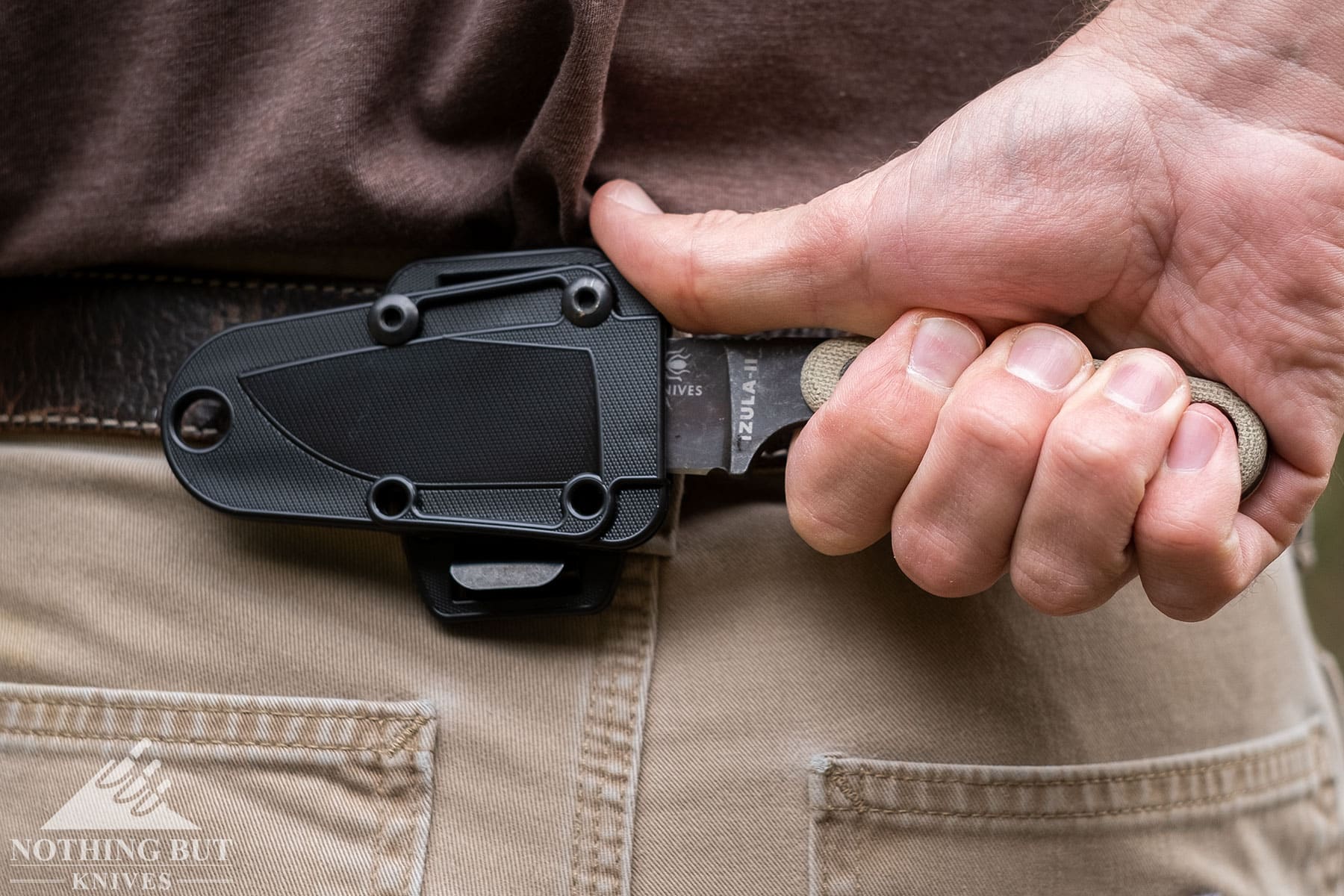
The more obvious comparisons are with the OKC Rat 3, the Esee Izula II, and the Esee Xancudo. With both the Rat III and Izula II you have more immediate adaptability. They come with Kydex sheaths with changeable belt clips. In the Rat III’s case you can actually buy it stock with a Tek-Lok and MOLLE-compatible straps.
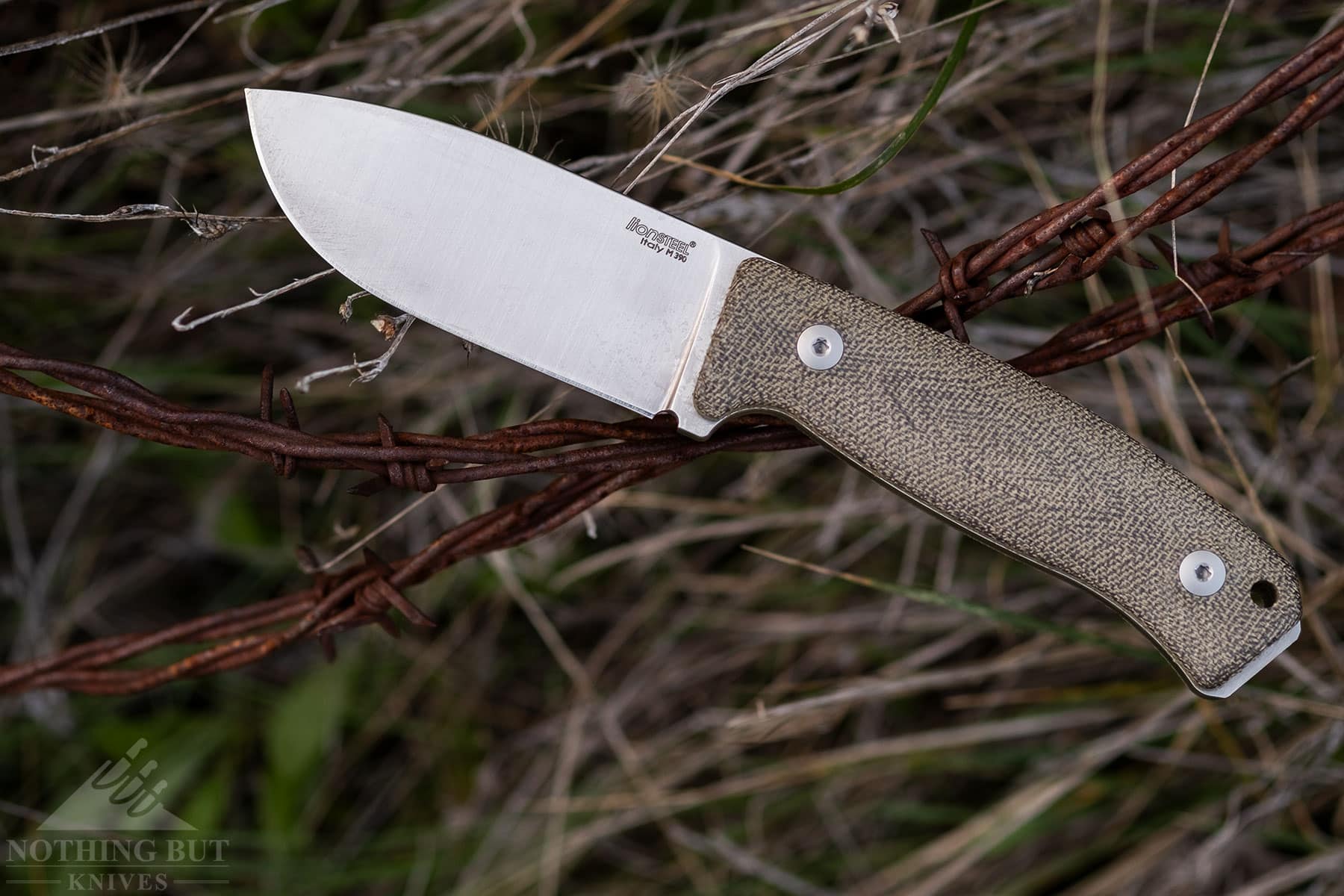
The LionSTEEL M2M also makes a good comparison. The price and size are about the same, although the ergonomics will likely be a little different due to the M2M’s much longer handle. The M2M also ships with a leather sheath, but it is a leather sheath that is much more versatile than the horizontal carry only sheath that ships with the Bradford Guardian.
The White River Knives Exodus 4 is a great option if you want a lightweight horizontal carry knife with a handle that will accommodate your whole hand.
If you are looking for something a little more compact at half the price, the Kizer Smolt might be the way to go.
The Guardian stands out from a lot of these knives with its steel, its leather sheath, and the contouring of its design. It’s the gentleman carry of this group. Where they’re all small, robust, outdoor knives, the Guardian 3 can get dirty and come out still looking like a fine-crafted tool. The Guardian’s spear point and tough blade finish mean you can get this thing dirty after a lot of use and get it cleaned up with a fair assurance that the the edge and overall look will come out pretty much how it looked before you skinned a deer or carved a spoon.
We often find ourselves carrying the Guardian 3 as a nimbler sidekick to larger survival knives.
Guardian 3 Competitor Table (Bushcraft Knives That are Similar in Cost or Size)
| Knife | Overall Size | Cost | Steel |
| Bradford Guardian 3 | 6.75″ | $130 | AEB-L or Magnacut or M390 |
| Esee Izula II | 6.75″ | $85 | 1095 |
| LionSteel M2M | 8″ | $169 | Bohler M390 |
| White River Knives Exodus 4 | 8.5” | $175 | S35VN |
| OKC Rat 3 | 7.6″ | $73 | 1095 |
Final Thoughts on this Classic American Fixed Blade
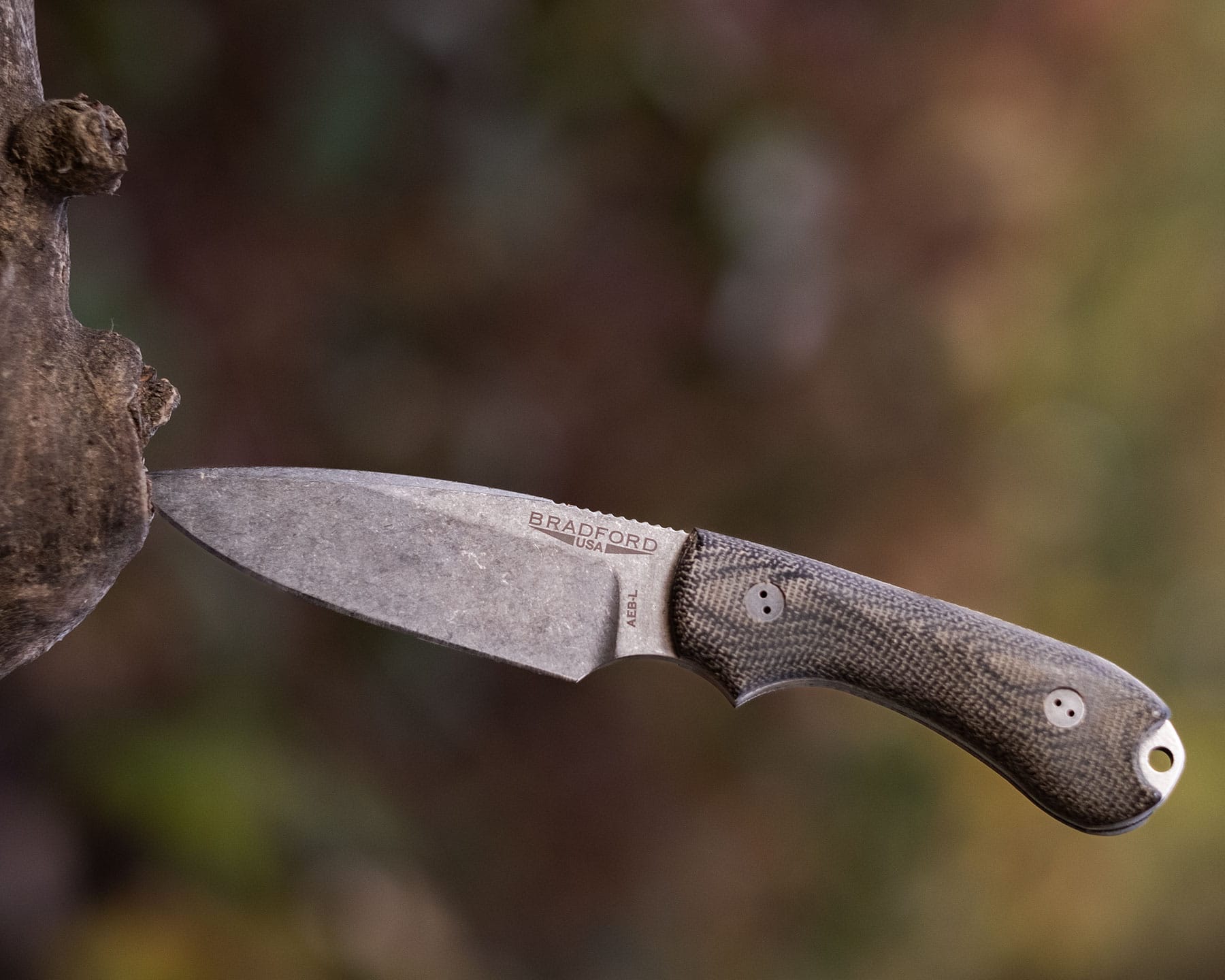
It’s hard not to love this knife. I was expecting to like it, and even though it ended up not being the thing I expected it to be, it turned out to be a whole other cool thing. It’s not for hacking away at wood, or for self defense. It’s for cutting things. Holding it gives me an overwhelming feeling of ability. It cuts, and it feels comfortable when it cuts. It’s easy to carry and modify and the steel is excellent at taking abuse.
It’s limited with the ferro rod and its size, but Bradford makes other knives that are big enough to lop off tree branches. The Guardian 3 isn’t made for trail blazing, it’s made for utility and it operates very well in that capacity.

Hey there,
great review, thanks a lot for sharing your thoughts.
One question came to my mind maybe you could help me with.
You mention in your review, that the knife is made of N690, but all your pictures show an AEB-L steel.
So what versoin did you review?
Kind regards and greetings from Germany
Michael
Hi, Michael,
The knife pictured is the AEB-L version. My assumption when I first ordered it was that all Guardians were made with Bohler N690 or M390, so I didn’t bother to look too close at what we had. It wasn’t until we’d already published the review that I realized what those letters mean, and I’ve been lazy about updating the review to correct my mistake.
For what it’s worth, AEB-L, M390, and N690 are all made by Bohler-Uddeholm and have roughly the same working hardness. I’ve used other Bohler steels since this review and can say that performance won’t be drastically different across the different steel versions aside from somewhat better tensile strength and edge retention with M390 and N690.
Hope this helps, and thanks for reminding me that I really need to get around to updating this review.
who is the girl with the knife?
Hi Mario. She is a friend that helped out with this review, but I don’t think she wants her name shared online.
My one question is
Does the girl in the pictures really carry a knife
Would be nice if she does..
She does when she is camping or hiking, but I don’t think she carries a fixed blade regularly when in town. Just a pocket knife then.
I have both the Guardian 3 and Guardian 4 both in N690 and they are my 2 favorite fixed blades in my collection.I bought the Guardian 3 for an EDC knife so I went with the flat G-10 scales for less of an imprint but with my Guardian 4 micarta was a must as it’s my belt knife for when I go camping,hiking,fishing,hunting,etc.I always alternate between my EDC folders,autos and OTFs but my Guardian 3 and my Leatherman Wave+ are permanent fixtures in my EDC gear..the Guardian 3 and 4 are masterpieces of a knife design IMO.they feel great in my hand like they were designed just for me..I’ve been thinking about buying the Guardian 4.5 or 5.5 in 3V or Cruwear..if they made it with a Scandi grind I would buy it immediately..I want the 4.5 or 5.5 with a Scandi grind because it would make for a perfect bushcraft knife.I love finger choils but the more traditional straight handle of the .5 models would be better for a bushcraft knife..with all of that being said,this was an excellent review and now as of June 2021 the Bradford Guardian 3 is now also available in D2
Oh, trust me, we’ve been eyeing that Bradford Guardian in D2 steel. Pictures of it will probably be showing up in this review pretty soon.
And I agree about getting a Guardian with a Scandi grind. That type of thing could turn the Guardian 3 into a fancy Mora.
BladeHQ also offers exclusive models of the Guardian series in both CPM-M4 and 3V, both excellent steels, if you’re looking to update the article. Not sure what other retailers offer for exclusives, but I’m sure there’s more.
Cheers.
The M4 and 3V versions look pretty sweet, but Bradford is coming out with so many different versions all the time that I slowed down on keeping this blog updated with them. Especially since some of them are limited releases.
I’ve been keeping an eye on the Guardian stuff, though, and there might be some kind of table forthcoming here that shows all the Guardian 3 iterations as they’re currently available… whenever we have the time to make it.
I’ve been wanting a Guardian 3 for quite some time now but I can’t decide between the 3 & 3.5. Great review by the way.
I haven’t tried the 3.5. I definitely like the look of the 3 better, but the plain lines on the 3.5’s handle seem like they would be more comfortable. I’m more than happy with what I have, though.
Bradford Gaurdian 3.2 (magnacut): I finally found the right Bradford Gaurdian for me. I was not comfortable with the Gaurdian 3’s direct choil to blade transition on such a small knife, then low and behold Bradford has addressed that concern by offering the 3.2.
I went with micarta scales and the kydex sheath, based on what I have read here and elsewhere regarding the belt size concerns for the leather sheath. On my example, the kydex sheath strikes the perfect balance between solid retention and ease of deployment.
The blade came shaving sharp, though not “hair popping” due to the geometry of the edge. Primary and secondary edge bevels were perfectly even. The fit and finish of the handle scales to the blade is great, there are no discernable transition points felt when the knife is being used.
Cons: it would be nice for Bradford to offer the gaurdians with a price option to forgo the leather for the kydex sheath, instead of outright buying the kydex sheath on of top of the leather sheath. There is no area aside from the cutting edge to scrape a ferrocerium rod. I assume large handed folks are going to find the handle on the short side, as my medium sized hands completely envelop the handle.
I haven’t picked up that 3.2 yet, but extending the knife with a full finger choil was definitely a good idea on their part.
I loved mine, but lost it when it fell out of the sheath. Get the kydex.
Thanks for the review! I’ve have my Guardian 3 M390 for years! My favorite EDC. I am a leather sheath guy…but the Guardian 3 leather sheath stretches and the knife eventually falls out. I’ve wet formed the sheath twice…but I stay nervous using it. I’m not a fan of kydex (I’m kinda snotty when it comes to leather as my preference), but the kydex secures the knife a LOT better!
I’ve heard this about their leather sheaths before. Mine is still holding up okay after 4 or 5 years of semi-regular use, but it does feel like a few more years of wear might take it past the slipping point. Thanks for the input.
Is there a reason why the sheaths look armature?
I’ve had a Bradford Guardian 4 in N690 for years now. I have to mention the story behind the knife. After owning tons of knives for mostly camp chores, cleaning trout and some bushcraft, I researched and read tons of reviews which lead me to wanting a Bradford. Even though I own and am the master distiller of Chamucos Tequila, I don’t party on New Years Eve. So around 9pm on New Years Eve I decided I really wanted a G4. Everyone was out of stock. I innocently dailled Bradford knives thinking I’d leave a voicemail but Brad actually answered the phone. Couldn’t believe it. He politely told me that he was out of Guardian 4 knives but said he would go out to his shop and finish one up and ship it asap. To my amazement it arrived on January 2nd. Moving years later I moved to Mexico to better manage my business and get my wife back to her family. Mexico has weird laws. You can walk around in public with a machete but a pocket knife is illegal. A fexed blade is required to be under 4” and concealed. Open carry is illegal. So I ordered a Guardian 3.2 in MagnaCut with G10 ghost scales. I live on the beach in the tropics and it hot, humid and salty. Everything rusts. Even most stainless rusts. The 3.2 is my go to EDC and it’s always with me. Get one. Get MagnaCut too. I have both the leather and kydex sheaths. I prefer kydex because it allows my knife to dry when it gets wet.
Wow! Thanks for the insights, Mark. Great story about getting ahold of Brad in the Bradford shop. Now we have to try some Chamucos Tequila. Comments like yours make running this site fun.